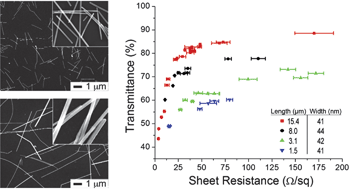The effect of nanowire length and diameter on the properties of transparent, conducting nanowire films†
Abstract
This article describes how the dimensions of nanowires affect the transmittance and sheet resistance of a random nanowire network. Silver nanowires with independently controlled lengths and diameters were synthesized with a gram-scale polyol synthesis by controlling the reaction temperature and time. Characterization of films composed of nanowires of different lengths but the same diameter enabled the quantification of the effect of length on the conductance and transmittance of silver nanowire films. Finite-difference time-domain calculations were used to determine the effect of nanowire diameter, overlap, and hole size on the transmittance of a nanowire network. For individual nanowires with diameters greater than 50 nm, increasing diameter increases the electrical conductance to optical extinction ratio, but the opposite is true for nanowires with diameters less than this size. Calculations and experimental data show that for a random network of nanowires, decreasing nanowire diameter increases the number density of nanowires at a given transmittance, leading to improved connectivity and conductivity at high transmittance (>90%). This information will facilitate the design of transparent, conducting nanowire films for flexible displays, organic light emitting diodes and thin-film solar cells.

- This article is part of the themed collection: Nanoscale 10th Anniversary: Top Cited Articles

 Please wait while we load your content...
Please wait while we load your content...